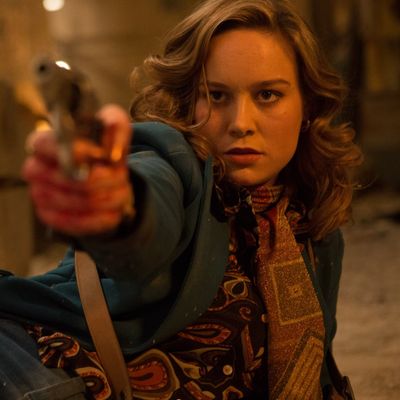
Ben Wheatley’s Free Fire is a movie about guns: It’s set entirely in a warehouse, as an arms deal between a group of IRA members (led by Cillian Murphy), some Americans (Brie Larson and Armie Hammer), and a South African (Sharlto Copley) messily unravels. Once the deal goes bad, the multiple parties involved arm themselves and let loose, and the film erupts into a bloody gunfight that lasts the better part of an hour.
That doesn’t make Free Fire sound all that different from the symphonies of violence that have come to define this year’s studio blockbusters. So far we’ve seen Logan, a film in which Hugh Jackman eviscerates an endless number of grunts with his claws; Kong: Skull Island, a film in which a giant monkey and demonic lizards massacre a bunch of soldiers and scientists; The Fate of the Furious, a film in which a bunch of a family of car thieves–turned–international operatives kill a bunch of “separatists” in Russia; and John Wick 2, a film in which Keanu Reeves kills everyone. While these movies also involve villains with actual names and intentions, and come in styles ranging from the sublime (John Wick 2) to the cartoonish (Fate of the Furious), their most prominent actions scenes see the heroines bringing cool, swashbuckling death down upon legions of faceless henchmen.
Seen from a lens most of us would agree with in real life — violence is bad, and all deaths are tragic — then this string of killings begins to seem almost absurd. Of course, the henchmen are faceless for a reason; it’s the only way to make this scale of killing palatable. When characters we’ve come to know die, as they do in Logan and Kong, the scenes are carefully calibrated to stand out from the rest of the anonymous, space-filling murder. But regardless of how you feel morally or ethically about the practice of massacres being perpetrated by the protagonists of your popcorn entertainment, the preponderance of those cinematic spree killings makes the tone and approach of Free Fire’s violence a welcome relief.
Free Fire is certainly violent: Everyone in the movie absorbs at least a bullet or two, and some meet fates far more gruesome than that. But unlike in the average mainstream tentpole of today, the viewer must actually reckon with the fact that this havoc is being perpetrated by and on characters with names and faces. While the question of whether you like these people might depend on your appetite for a few things — insults, bad haircuts, 1970s kitsch — you certainly get to know them. Thanks to a top-notch cast, which features Copley at his most antic, Hammer playing cool, Larson’s remarkable presence, and Sam Riley and Jack Reynor trying to steal the show, you may even root for some of them. Because we’ve got main characters on all sides of the carnage, the action never morphs into one of those video-game-style set pieces. The gunfights remain unpredictable, haphazard, and, most of all, funny — until a bullet meets its mark, and you remember that guns kill people.
Wheatley told me that he based the film’s close quarters and seemingly incompetent gunfighting on an FBI ballistics breakdown recounting a real-life incident that took place in Miami. “It was really messy. You’re like, Wow, these guys are trained, and they’re missing a lot. It’s horrible and hard and goes on for a long time in very close quarters, and it was absolutely not what I’d ever seen in a movie,” Wheatley said. “I wanted to do something that was like that, that took your action movie and just crushed it down like a piece of coal into a bit of diamond really deep underground.”
He also wanted the action to work on a human scale, avoiding the stock characters that tend to populate typical period crime movies. That led to the concept (taken from real life) of the IRA buying American weapons, combined with elements of ’70s counterculture and players who look like they could have existed at the time — and whose faces you would actually see.
“You know you’re in trouble when your hero’s facing off against a load of guys in gas masks, which means none of them have characters and they’re all the same stuntman getting killed again and again and again,” Wheatley says. “I was watching something the other day with my wife, and she’s going, ‘Well, if we change the sound on this, this is really sad, this film — this is like this serial killer guy running around murdering people. He’s not a hero, he’s a murderer.’”
That led to the shifting allegiances and relatively balanced sides of Free Fire, in which it’s never quite clear who should win — in fact, most of the participants in the fight are hardly clear why they’re fighting at all. The absurdity of what’s happening is never far from the minds of either the characters or the audience. “In a genre sense, it’s like, Why do you like it, why are you enjoying it? It doesn’t mean you can’t enjoy it as well, but there is a question there,” Wheatley said. “It becomes this really complex thing of levels of liking characters and then they’re getting set off against each other and you’re feeling guilty and happy at the same time.”
And for a movie that features many loving close-ups of guns, Free Fire winds up making a stellar case for gun control: If the characters weren’t armed in the first place, everything would’ve gone a hell of a lot smoother.




